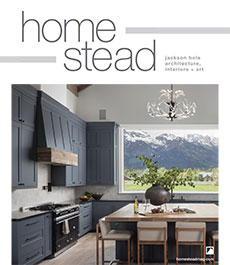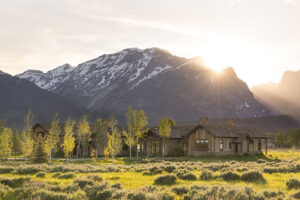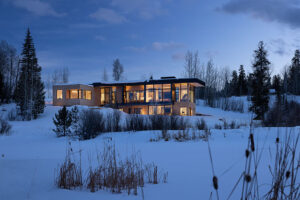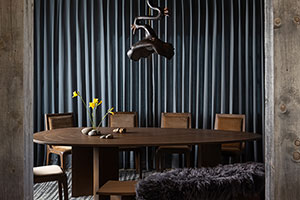Pulse
+ Story by Tammy Christel
Jackson’s Western art scene vibrates with quixotic enterprise. Contemporary artists are injecting fresh form and interpretation into Jackson’s traditional themes, and risk-taking abounds. Artists eschew targeting collectors via established galleries, and while contemporary art will never replace traditional Western art, the latter will not stifle the former. Western subject matter is valuable, but it has come to share the stage with prescient, experimental work. Jackson’s good fortune is that traditional and contemporary movements enrich each other, and barriers are bending, even collapsing.
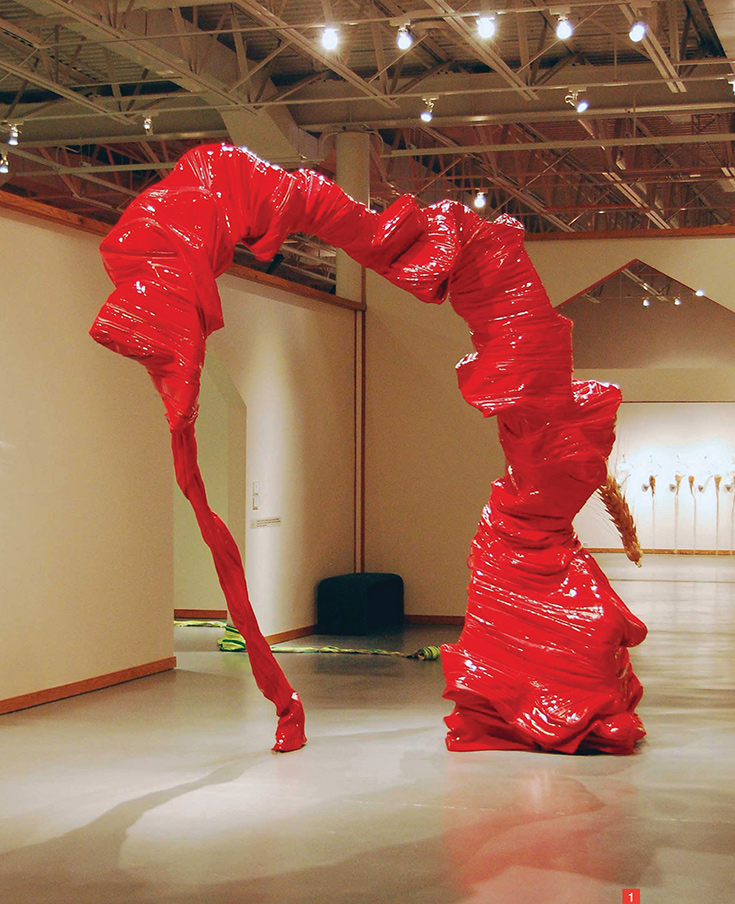
1. Abbie Miller’s vinyl-and-zipper sculpture, “Squeezed Arch,” merges fiber arts and architecture.
“There’s a definite buzz going around now,” says sculptor Natalie Clark. Her color-saturated, multi-surfaced towers electrify Jackson’s downtown buckboard streetscape. Heavily influenced by the Tetons’ magnetic power, her sculptures freely explore global elements, such as Africa’s indigenous symbols and Bhutan’s multi-hued, symbolic prayer flags.
“Jackson’s art foundation rests on representational work; our history is built on that,” says Clark. “But a new, sophisticated clientele exercises confidence about mixing contemporary art into their Western homes. Collectors buy work they know artists want to make, not because they’re looking for product, but for true value.”
Sometimes, traditional work subtly shifts, embracing world culture. Equine and wildlife artist September Vhay creates large-scale, expansive works that bring out the nature of her medium. Experimenting with what she calls “looseness,” Vhay feels freer to follow her own voice.
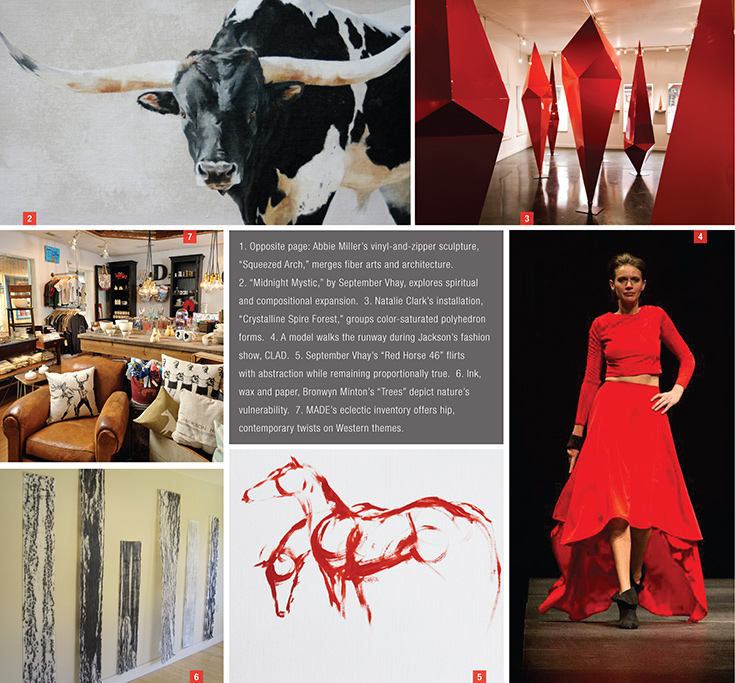
2. “Midnight Mystic,” by September Vhay, explores spiritual and compositional expansion.
3. Natalie Clark’s installation, “Crystalline Spire Forest,” groups color-saturated polyhedron forms.
4. A model walks the runway during Jackson’s fashion show, CLAD.
5. September Vhay’s “Red Horse 46” flirts with abstraction while remaining proportionally true.
6. Ink, wax and paper, Bronwyn Minton’s “Trees” depict nature’s vulnerability.
7. MADE’s eclectic inventory offers hip, contemporary twists on Western themes.
“Maximum expression with minimal gesture,” says Vhay. “My red horses and bokeh paintings are similar in composition; there’s a duality between Western icons and the tradition of ancient Japanese brush painting. My proportions are correct, but the work is abstract. The intellectual exercise is new.”
Quantitative mass and individualism are mixing it up, changing Jackson’s creative philosophy, says Art Association Director of Painting, Drawing and Printmaking Tom Woodhouse.
“What I see is more out-in-the-open, contemporary, nontraditional subject matter; it’s not hidden away,” Woodhouse remarks. “Even plein air and wildlife artists are approaching their work more dynamically, not feeling the need to adhere to safe, outmoded standards. The confidence comes from sheer numbers. More people are in town. Kids who grew up here went away to influential, stimulating schools, and their work is infused by what they were exposed to during their time away. How do you educate people in traditional ways and still create opportunities to make exciting, new art? I want to bring those concepts together.”
At glass artist John Frechette’s store, MADE, local artists gain unprecedented worldwide market reach. Frechette’s business deftly utilizes social media to showcase hip, handmade Western art. The Internet’s potential dawned on Frechette as he roamed a concourse in Detroit’s airport. A mesmerizing installation of glass, music and light stopped him in his tracks. Frechette checked Foursquare, an application allowing users to share their happened-upon inspirations, and instantly discovered rave reviews of the tunnel connecting terminals A and C.
“There’s nothing better than having someone say, ‘I LOVE your glass belt buckles!’ It’s awesome,” exclaims Frechette. “It gets even cooler when they take them back to Australia and someone else there calls to buy one. I look at our Web sales and think, ‘How did this guy making glass belt buckles on his dining room table two years ago get to selling them to someone in Australia today?’ ”
In 2011, clothing designer and sculptor Abbie Miller produced Jackson’s first full-on runway fashion show, CLAD, turning an immobile arts scene on its head. Miller’s sculptures were always clothing-based, but gradually, her work became a personal narrative relating to women’s issues. Wearing and exhibiting architectural, fabulous clothing was liberating. Miller’s designs earned her a coveted finalist position in the Portland Art Museum’s Contemporary Northwest Art Awards.
“There’s an obvious connection between my sculpture and my clothing. They both go from 2-D to 3-D, and they deal with frames: either hand-constructed or the human body’s frame. My zipper sculptures are statements about exerting control over chaos; the zipper harnessing tension,” Miller says. “Clothing is the same, in that we have personal identities and histories. Clothing controls our physical environment by protecting us, but it also creates a sense of control over our identities and how we present ourselves.”
In her work, museum curator Bronwyn Minton mixes observations about the effects of climate change in the West and her affinity for curating group storytelling exhibitions. Sixty-five artists contributed to the National Museum of Wildlife Art’s wildly popular “Silver Spot,” an exhibition based on a vintage comic book story. Thoroughly connected to the natural world, Minton’s art is at once highly contemporary, thematically universal and “readable.”
“I came out here when I was 10; my dad is an environmental educator and my mom an environmental health educator and organic gardener,” Minton recalls. “My work reflects what I see and feel when I’m outdoors, collecting plants to draw and cataloging them. My burnt trees document forest fires as well as individual trees. They’re fragile, and the charcoal easily comes off. This is a moment in time in that tree’s life.”
Jackson’s art success stories no longer require knowing somebody’s influential mother, a board member or philanthropist. Social issues, global warming, e-commerce platforms, brave new collecting preferences and reinterpretations of Western art have arrived. Artists are displaying potent capabilities, leading nonprofits and establishing their own spirited legacies. Quite often, they owe a debt to the valley’s earliest artists, because Jackson’s true spirit is making your own way.
< Previous Editorial | Next Editorial >
